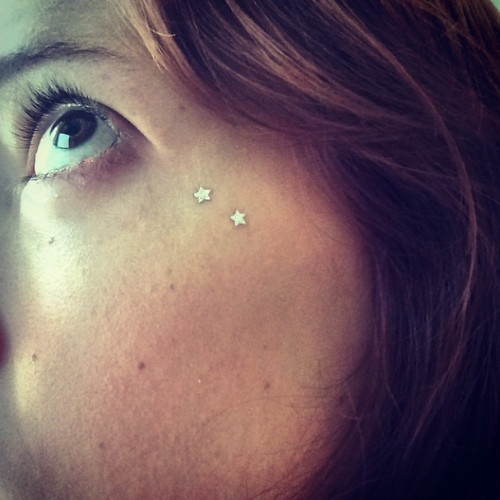Alto's Odyssey tips and tricks to help you escape lemurs, ride walls over chasms, and more!

Tired of winter? So is Team Alto: The development team behind Alto's Adventure has traded the snow and ice of its original endless runner for sand, canyons, waterfalls, birds of paradise, and more.
But Alto's Odyssey isn't only about beautiful, summery landscapes: The first game's characters have all-new terrain types to learn, and goals to accomplish. That includes running away from angry lemurs, soaring through the sky with birds of paradise, grinding on vines that snap away if you stay on them too long, flying into the sky on a balloon bounce, and getting caught up in a tornado.
I've played the entire game through, and the goals are just as challenging as the original Alto — and twice as fun. If you're struggling to land a combo or curious how to best ride walls with your sandboard to escape chasms, let me help you on your own journey.
Beware: Spoilers abound for the game below. Don't read this unless you don't mind getting spoiled on a few of the new aspects of the game!
Backflips are (still) your bread and butter for gaining speed

As with Alto's Adventure, the backflip — where you tap to jump and hold that tap to pull your characters legs in for a flip — is the easiest trick you can do in the game: You need only a bit of speed and elevation.
Each character handles backflips a bit differently: Alto has an all-purpose jump, while Maya needs a little more speed to get elevation; Maya rotates much more quickly while in the flip, however, while characters like Paz have great land speed but poor rotation.
Whether you're trying to escape a lemur or build up a trick score to activate your wingsuit, you can use backflips to get yourself started before encountering chain-based tricks like grinding, walls, balloons, and tornadoes.
Master your iPhone in minutes
iMore offers spot-on advice and guidance from our team of experts, with decades of Apple device experience to lean on. Learn more with iMore!

You can also do backflips close to the ground to gain even more trick points and a better speed boost, or continue holding to rotate into a double, triple, or even quadruple backflip.
Every trick you do adds to your multiplier
Any trick you do between leaving the ground and returning to it adds points to your trick score: For instance, doing a single backflip will net you 10 points. But when you do multiple tricks in a single jump, each trick not only has its own separate point value — every trick you do adds to a multiplier.
To give you an example, if you did a double backflip followed by a chasm jump, your counter would look as follows:
- 10 points for a single backflip
- 60 points for making it a double backflip
- 50 points for successfully not falling into the chasm
Your point total from tricks alone is 120, but in addition, you'll add a multiplier for every trick you've done — in this case, 3 — to make your total point total for the run 360.
Balloons, tornadoes, ponds, and rocks are a trick-chaining paradise
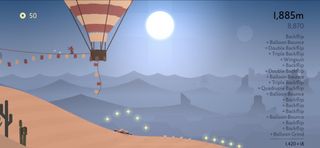
Alto's Odyssey qualifies "the ground" as the sand slopes themselves: Other objects just count toward your trick score. You can use these objects — which include hot air balloons, water ponds, tornadoes, rocks, ramps, vine grinds, rope grinds, ship grinds, ruin grinds, and rock walls — to help chain tricks and up your trick score.
When you land on a grind-, ramp-, or wall-based item, you may have ended your initial jump or backflip rotation, but you continue grinding and rack up additional points for your current combo. When you finish the grind, you can flip off it again to continue racking up points.
TIP: When you buy the wingsuit, you can also use it to chain tricks by avoiding the ground, or sending your character back up into the sky to do more jump rotations.
For instance, if I did a backflip into a wall grind, wall jumped onto a balloon grind, then backflipped off of that, my score would look like this:
- 10 points for a single backflip
- 5 points per meter of wall grind (let's say 35 points total)
- 20 points for a wall jump
- 5 points per meter of balloon grind (40 points total)
- 10 points for a single backflip
That'd give me 115 points for the raw tricks before adding a 5x multiplier, bringing me to 575.
But the best trick-chaining items in the game are arguably Odyssey's balloons, tornadoes, rocks, and water ponds. Unlike grinds, you don't have to land on them with your board — you can bounce off their surface (or, in the case of ponds, slingshot through the water) facing any way you choose.
Bouncing off these items won't end your backflip or jump chain, even if you briefly let go of your tap-and-hold — you can re-hold to continue whatever rotation you were on. For instance, if I did a double backflip off a cliff, landed on a balloon, and rotated two more times before landing back on the sand, it would look like this:
- 10 points for a single backflip
- 60 points for making it a double
- 60 points for bouncing on a balloon
- 200 points for a triple backflip
- 600 points for a quadruple backflip
That's 930 points raw, and the 5x multiplier makes it a total 4650 trick score. Not too shabby for what otherwise would have been two double backflips!
Though Alto caps its score for backflips at quadruples, you can continue to rack up individual backflip scores after that initial burst — I've racked up 20x multipliers from a well-chained series of balloons and backflips before.
Use the day and environment to your advantage

Alto's Odyssey, like its predecessor, has time pass as you sandboard through the desert. In addition to special achievements for sandboarding through a whole day and night, you'll get a one-off addition of 1000 points to your trick score every time you witness a sunrise. If you're trying to go for a high score, timing your runs with the rising of the sun can be a big advantage.
Odyssey also gives points at the end of the game for how many landscapes (or, as the game calls them, "biomes") you've witnessed, as well as how many chasms you've jumped during your run.
Learn your characters

All the characters from Alto's Adventure are back to sandboard their way through Odyssey, along with a new desert friend, Sumara, whom you'll meet after reaching level 51. Each of them has specific strengths and weaknesses, and you can achieve certain goals more easily by targeting your runs with specific characters.
Maya (and Sumara) are the best at backflipping close to the ground
Because both Maya and Sumara have quick rotation on their flips, you can use them to get the coveted "backflipping close to the ground" goal early on in the game: On the first few hills, tap to jump about 5m before peak of the dune; these jumps will let your character's head come within 8 meters of the ground, netting you a nice 300 points and getting the goal, to boot. Maya (and Alto, too) is also a great pick for goals that require precision: Because of her slower sandboarding speed, you may be able to spot items (like super coins) in advance and line up your tricks accordingly to grab that goal.
Paz can smash multiple rocks quickly (and bounce on them, too)
What Paz lacks in rotational speed, the bigger boarder makes up in pure ground speed. Once you get him grinding — especially on rock walls and balloons — he'll fly down the map, making him a great candidate for destroying multiple rocks quickly (or bouncing on them).
Izel offers versatility
Izel, introduced at level 31, is responsible for all the gadgets you can buy (with virtual money only, thankfully — no in-app purchases to be found here) in the Workshop. She's also one of the most versatile characters in the game: She can flip faster than Alto and Paz, outspeed Maya with her rocket sandboard, and she has the best wingsuit control of any character in the game. (No surprise: She invented it.)
Felipe and Sumara can escape sticky situations with a double jump
Before rotating for a flip, both Felipe and Sumara can extend their air at any time with a second tap to double jump. It's a great way to time a rock bounce or kiss the rail on a grind — as well as save yourself from almost certain annihilation falling into a chasm.
Sumara brings the best of all the characters together (and lemurs don't bug her)
The newest member of Alto's cadre, Sumara unlocks at Level 51 and combines the quick flip skills of Maya with Izel's versatility and Felipe's double-jump. In addition, while Sumara's tricks will irritate the lemurs who live in the desert, they won't actually attack her board, giving you the freedom to take your time amongst the desert wildlife.
Jump baby jump (to avoid lemurs)
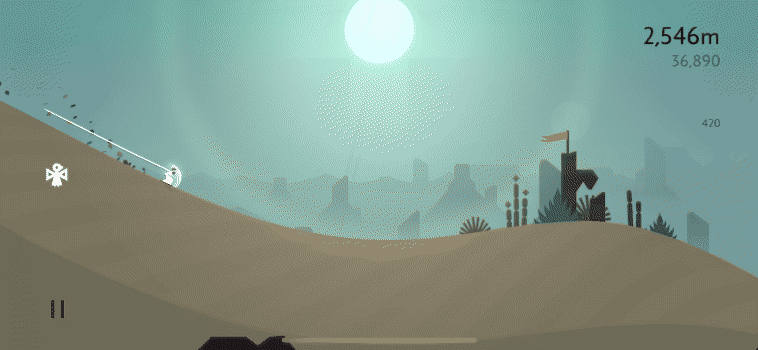
Speaking of lemurs: The Elders of Alto's mountain village may not have made the trek to the desert, but in their place you'll find some wildlife not too thrilled to have sandboarders dropping into their environs.
Like the Elders before them, lemurs pop up every few thousand meters you snowboard. Unlike Elders, lemurs can jump and run on grinds: You can't rest on your laurels (or balloon lines) when one's chasing you.
The best way to quickly build speed to flee a lemur is with quick backflips, but you can chain tricks to get an even bigger boost. Just be careful of grinding too long if a lemur is in close pursuit — they'll jump on your board to put an immediate stop your run.
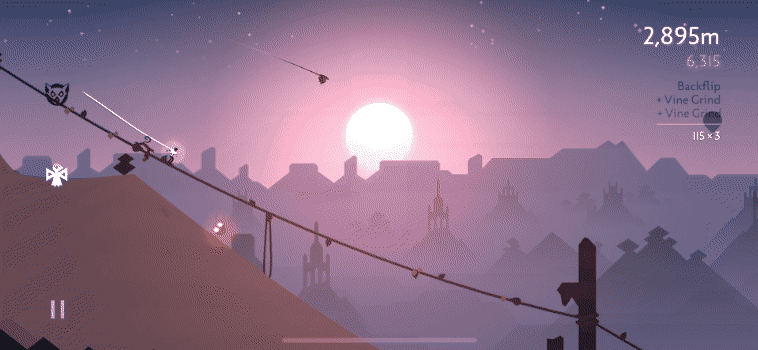
One of the ways you can dodge lemurs even if your backflipping ability isn't great is to out-jump them — if it's starting to get too close for comfort, wait until the lemur starts to leap in the air, then jump yourself. If you get the timing right, the lemur will barely miss out on grabbing your board; from there, you can hopefully pull off a trick to regain your speed.
Drop the vine grind before it drops you

One of the new additions to Odyssey is Vine grinds. Like the flag grinds of Alto's Adventure, vines are hoisted in the air on various types of poles and trees; unlike those flag grinds, the vines can break once you're riding on them for a certain period of time. Alto's haptic feedback and sound effects are both key here — you can feel and hear the vine start to give way, and if you want to save your combo, you can quickly jump to the next grind or flip off before you get dumped into the sand.
Wall grinds are all about those taps

Wall grinding is the biggest gameplay change in Odyssey, allowing players to flip their boards and vertically ride canyons straight up, over chasms, and at angles. It's a bit trickier to master than straight backflips, but the combo possibilities make these new tricks completely worth it.
To start, you'll need to pick up a sandboard from Izel's workshop — it'll cost you 750 coins, which you should be able to earn fairly quickly on your opening runs.
Release early and tap to master the wall grind
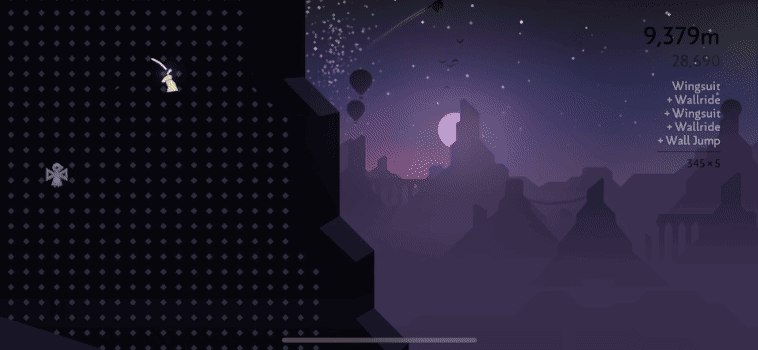
Grinding against a wall or canyon is pretty easy: Once you jump onto it, hold your finger down (like you might during a backflip) until you reach the end of the wall.
But to truly master canyon grinding, you'll want to get control of the wall jump — an additional 20-point trick awarded when you preemptively remove your finger off the screen to end a wall grind before the wall is done. Wall jumping will give you a small boost of momentum upward that you can either turn into a backflip or use to grab the wall again and ride even higher.
Wall jumping can be particularly effective because it's one of the fastest ways to get a quick combo score: You can jump and grab onto a wall multiple times with a tap-hold-tap-hold-tap-hold combination of your fingers, racking up crazy multipliers in the process.
Practice wall grinding in the tutorial
My best advice for wall grinding? Play the tutorial level multiple times after purchasing your sandboard. You can access the tutorial levels at any time without resetting your progress by doing the following:
- Tap the Menu button from the main screen.
- Select the Settings tab.
- Scroll down to the Replay Tutorials section and tap on Sandboard.
You won't be able to progress in the tutorial until you've completed the trick, but after your initial run, you can use this game mode to practice multiple wall jumps until you feel comfortable with the skill.
Use wall jumps to escape chasms without speed — or on the downslope
Like wingsuiting, wall grinds have an arc to them: If you start low, you'll ride up the wall, then slowly arc downward. You can preempt this arc by continuing to wall jump and re-grind, but if you find yourself on the downslope, you can also use wall jumping to gain just a little bit more air.
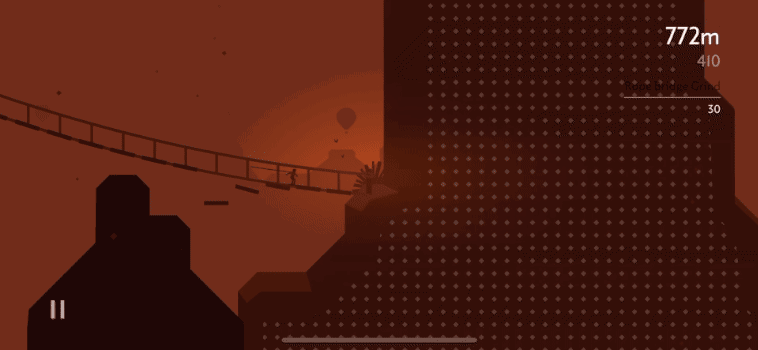
This trick is especially effective when crossing chasms that start you low and end high: The angle often isn't right for you to simply ride a wall from the start of a chasm to its end. Instead, use wall jumps mid-ride to keep your momentum and arc above the chasm's edge to land on the sand dunes instead of a rocky bottom.
Buy the wingsuit to save your skin from tricky rock walls and chasms
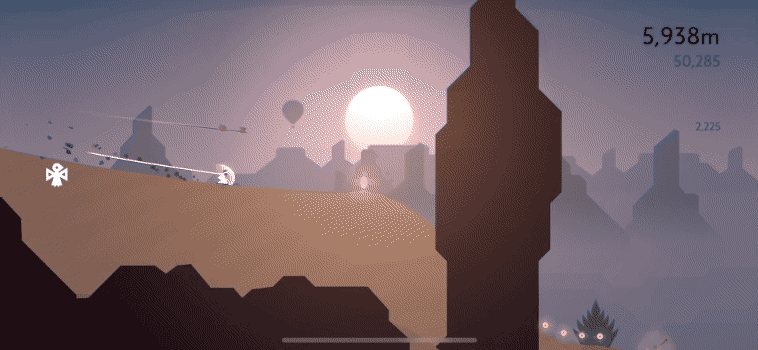
The wingsuit is your best secret weapon in the game: Available for 7500 in-game coins from Izel's Workshop, you can activate a glider mode that lets you swoop and loop-de-loop your way through the desert skies. Each player has a slightly different wingsuit, with Izel's — a freakin' rocket pack — as the undeniable best.
After you earn the wingsuit by pulling off a set number of tricks in a period of time, you can tap or 3D Touch to activate it at any time. How long that wingsuit lasts depends on its fuel level — you'll start at Level 0, but you can buy five more upgrades to extend its time for 1000-15,000 in-game coins, respectively.
An 8x combo or more will activate the wingsuit
By default, the wingsuit will activate after you pull off a set number of tricks in a certain period of time, but you can speed up that process by pulling off a trick combo with an 8x or more multiplier.
Land combos of 7x or less before the wingsuit timer runs out to refresh it
Additionally, you can refresh the fuel on a used wingsuit by landing combos with 1-7x multipliers before the wingsuit runs completely out. (If you can't land an 8x combo, make sure to end your trick chain before your wingsuit timer ends, or you'll have to earn it all over again.)
Turn off 3D Touch for fine control
3D Touch allows you to easily switch between wingsuiting and regular gameplay with just one hand, but while it's great to get into the suit, additional 3D Touch actions to end it can sometimes be tricky. Instead, I prefer disabling the feature if I know I want fine control over the wingsuit. You can do that by visiting the Menu button, then unchecking the 3D Touch box from the Settings screen.
Fly within 8 meters of the ground for bonus trick points
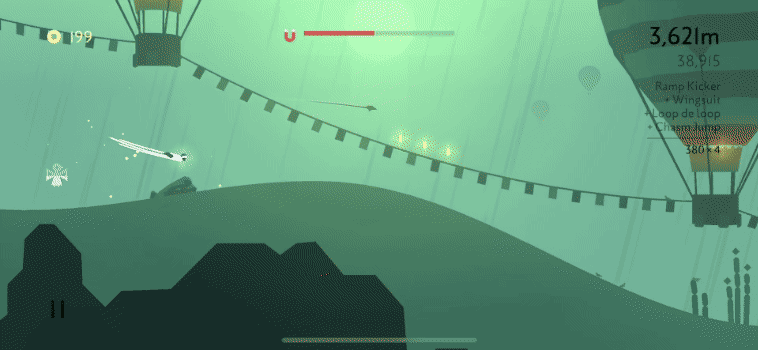
Want to rack up your overall trick points score? Proximity flying, or flying within 8 meters of the sand, will give you ongoing points. It's not unlike grinding, and you'll see sand effects, hear specific sounds, and feel certain haptics if you've triggered it.
Use the Wingsuit to fly with Birds of Paradise
During your run, you may disturb some other wildlife, though they won't be quite so testy as the lemurs. Your average vine-dwelling birds will simply fly away, but a few desert-native Birds of Paradise will follow and fly with you during your run. You can even fly through the sky with them if you activate your wingsuit while you have a bird companion.
Buy the Compass to focus your tricks in a specific biome
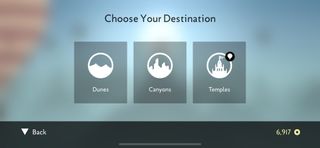
New to Odyssey is the 4000-coin Compass, which lets you switch between the game's various biomes after paying a 1000-coin fee. (Think of it like your own personal short-haul hot air balloon.)
Because each biome has specific features to it, certain goals may only be achievable in that area. For instance, you'll find wall-grinding primarily in The Canyons, while the Temples are full of balloons and ruin grinds; the Dunes have a mix of waterfalls, ponds, and vine grinds.
I rarely use the Compass because the biomes automatically cycle through each other every 4000-6000 meters or so, but it has come in handy for a few goals (like wall riding five canyons in a row).
Check out the workshop's other toys
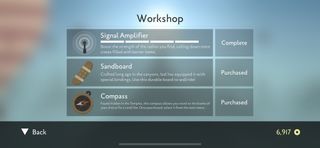
In addition to the Compass, Sandboard, and Wingsuit, Izel offers a variety of other useful gadgets for the sandboarding explorer:
- The Magnet Timer: A holdover from the first game, the magnet automatically pulls coins on the sand your way. You can upgrade it six levels starting with a 250-coin purchase; the total upgrade will cost you 16,750.
- The Lotus Timer: This glowing purple item is a rethink of the Feather from Alto's Adventure — it lets you hover slightly above the ground and keeps you immune to falls; it also automatically explodes any rocks in your path. Like the Magnet, you can upgrade the Lotus starting at 250 coins, with a total upgrade cost of 16,750.
- The Mysterious Radio and Signal Amplifier: If loot is your idea of a good time, check out the 5000-coin Mysterious Radio. When you pick it up on a run, it sends out a beacon that calls down a number of strange green crates. Smash them open, and you'll find coins, Magnet Timers, and more. You can use the Signal Amplifier to score even more crates on your runs; one level will cost you 500 coins, while the full upgrade will cost 9000.
- The Helmet: Worried about wrecking an all-time best scoring run with an unwieldy crash? Pick up a one-use helmet to save yourself from a single screw-up on the sand for 1500 in-game coins.
- Chasm Rescue: Like the helmet, you can save yourself one time from inadvertently falling down a chasm with this one-use 3000-coin tool.
Leave the menu screen open for a beautiful ambient screensaver

Okay, so this isn't really an in-game trick, but it's still lovely: If you leave the main menu screen open on Alto's Adventure for a few moments, the on-screen items will fade away, leaving the art of Alto's main screen to shift through day and night, storms and sunrises, all with Monument Valley II composer Todd Baker's beautiful ambient soundscape.
Other questions?
Want advice on landing a specific goal? I've played the entire game and am more than happy to assist.
Serenity was formerly the Managing Editor at iMore, and now works for Apple. She's been talking, writing about, and tinkering with Apple products since she was old enough to double-click. In her spare time, she sketches, sings, and in her secret superhero life, plays roller derby. Follow her on Twitter @settern.
Most Popular



